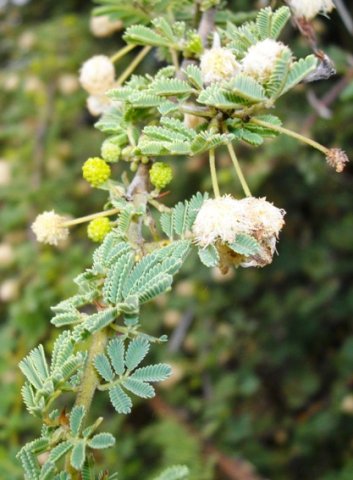Vachellia tortilis subsp. heteracantha

Author: Ivan Lätti
Photographer: Ivan Lätti
Vachellia tortilis subsp. heteracantha, previously Acacia tortilis, is a medium to large tree varying in height from 5 m to 20 m (SA Tree List No. 188 and No. 188.1). It has rough, grey or brown bark, vertically fissured on mature specimens.
The thorns are variable on a theme of paired, small, curved hooks and straight white spines. The two thorn shapes on the same twig contribute to identification of the species. V. luederitzii var. luederitzii also has hooks and straight spines, but its leaves are long, longer than 3 cm while V. tortilis leaves are shorter than 2 cm.
The leaves have the typical Vachellia bipinnate (twice compound) form. They are small, the leaflets compact in their arrangement or closely ranked, blue-green in colour. There is a small gland immediately below the lowest pair of leaflets on the leaf stalk.
The flowers are cream, white or dull yellow. In shape they are hairy spheres, appearing in summer. The pod is densely twisted or corkscrewed into a ball of spiralled pod.
There are several recognized subspecies of this tree, all but one of them beyond South Africa’s northern border where the biggest part of the species overall distribution occurs. The South African one is subsp. heteracantha with narrow, hairless pods. Subsp. spirocarpa growing on river banks with wider, hairy pods is found in Namibia. Heteracantha means different thorns or spines.
In South Africa V. tortilis subsp. heteracantha is distributed in all provinces except the Western and Eastern Cape. The habitat is dry woodland and bushveld at lower altitudes. The subspecies is not considered to be threatened in its habitat early in the twenty first century (Coates Palgrave, 2002; Schmidt, et al, 2002; http://redlist.sanbi.org).

